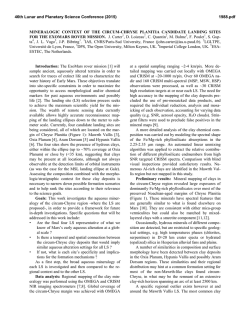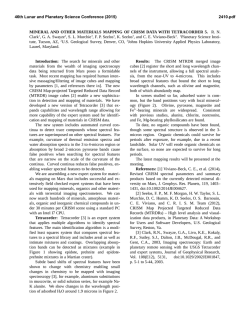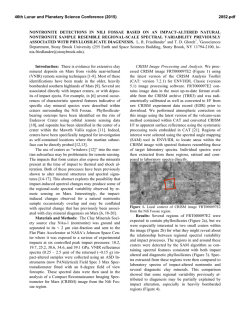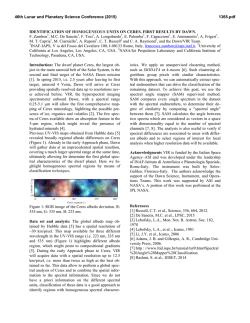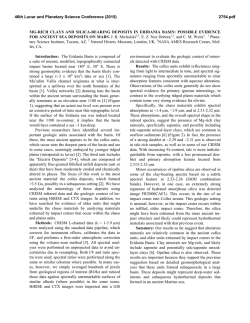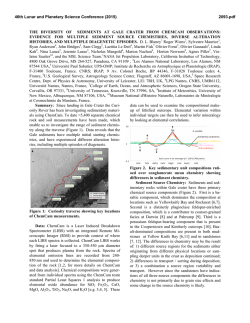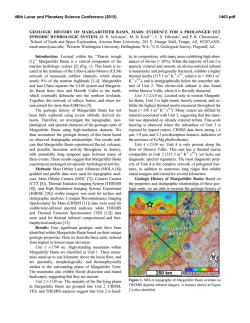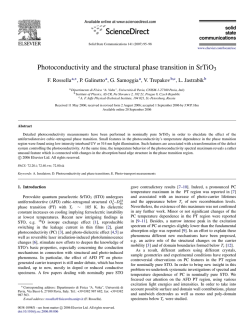
Acid-Alteration at Mawrth Vallis Between the Older Fe/Mg-Rich
46th Lunar and Planetary Science Conference (2015) 1455.pdf ACID ALTERATION AT MAWRTH VALLIS BETWEEN THE OLDER Fe/Mg-RICH CLAYS AND THE YOUNGER Al/Si-RICH CLAYS. J. L. Bishop1,2, C. Gross2, J. J. Wray3, B. Horgan4, C. E. Viviano-Beck5 and F. P. Seelos5, 1SETI Institute (Mountain View, CA; [email protected]), 2Freie Universität Berlin (Berlin, Germany), 3Georgia Institute of Technology (Atlanta, GA), 4Purdue University (West Lafayette, IN), 5JHUAPL (Laurel, MD). Widespread acidic alteration likely occurred at Mawrth Vallis at the interface of the lower Fe/Mgsmectite-rich unit and the upper Al/Si-rich clay-bearing outcrops. This study focusses on a spectrally unique material characterized by a doublet between 2.2 and 2.3 µm in CRISM spectra of multiple outcrops at Mawrth Vallis [1]. Evaluation of the spectral properties of this feature and the stratigraphy of this unit compared with neighboring aqueous materials suggests that acid alteration of the lower nontronite-like rocks is the source of this new phase exhibiting variable spectral bands at 2.21-2.23 and 2.26-2.28 µm. Introduction - Occurrence of “Doublet” Materials on Mars: Identification of unique surface materials containing a spectral doublet between 2.2-2.3 µm at Valles Marineris [2,3,4], at Noctis Labyrinthus [5], and at Mawrth Vallis [1,6] led to further investigation of these features together with neighboring aqueous outcrops and lab spectra of alteration materials and mixture components [7]. Multiple phases and alteration products were tested to explain the observed spectral doublet feature because no single mineral was found that could replicate this doublet signature. Jarosite or gibbsite mixed with Al-rich clays or hydrated silica could explain some of these features. Jarosite has been identified at Mawrth Vallis [8] and hydrated silica is frequently formed together with jarosite in acidic environments [e.g. 9]. Thus, jarosite plus silica would imply acidic conditions. However, a combination of halloysite and gibbsite could also replicate the observed doublet signature and indicate neutral conditions in a well-drained environment [10]. Both are alteration products of allophane [e.g.10], which has also been identified at Mawrth Vallis [11]. Finally, acid-alteration of clays was considered based on previous studies [12,13,14]. Acid alteration of nontronite and hectorite shifted the M-OH combination band near 2.3 µm toward shorter wavelengths and produced SiOH giving a product with a spectral doublet [12]. Impact shock on nontronite also disrupts the ~2.29 µm FeOH band and produces a new Al/Si-OH feature near 2.21 µm [15]. Figure 1. Spectra of “doublet“ materials observed in CRISM images at Mawrth Vallis illustrating a variety of band positions and relative intensities of the bands. Spectral Properties and Occurrence of Doublet Species at Mawrth Vallis: The “doublet” type spectral signatures were initially thought to be a spatial averaging of the M-OH combination (stretching and bending) vibrations found near 2.2 µm for AlOH and SiOH bonds and near 2.3 µm for 5 km Figure 2. Aqueous components from several CRISM images are overlain on an HRSC mosaic and DTM with 4X vertical exaggeration. Green regions exhibit a spectral doublet signature (marked by green arrows) and are frequently found above the thick, lower Fe/ Mg-smectite-rich unit (red) and below the upper Al/Si-rich phyllosilicate unit (blue). 46th Lunar and Planetary Science Conference (2015) FeOH and MgOH bonds in aluminosilicates. More careful analyses of these features at Mawrth Vallis [1] and detection and analyses of these features elsewhere on Mars [2-5] supports the presence of a unique phase that is responsible for this spectral doublet that varies in both intensity of the two bands and wavelength position of the bands near 2.21-2.23 µm and 2.26-2.28 µm (Fig. 1). Analyses of multiple CRISM images across Mawrth Vallis indicate the presence of small outcrops of this “doublet” species in many, but not all, locations where phyllosilicates are observed (Fig. 2). Views of CRISM images over MOLA topography (Figs 3, 4) show the presence of the “doublet” materials (green) on top of the Fe/Mg-smectite unit (red). Because of the spectral variability of this unit (Fig. 1) and its occurrence following emplacement of the Fe/Mg-smectite, it is likely an alteration product of this unit. Acid Alteration of Clays: Acid dissolution of clays occurs through weathering, the action of acidic mine waters and industrial applications, and is often referred to as acid activation of clays because of the resulting increased specific surface area, surface acidity and chemical reactivity of the clays [e.g.16]. Acid alteration of smectites proceeds through replacing the interlayer cations with H+, then leaching the Mg2+, Fe2+, Fe3+ and Al3+ cations from the octahedral layer, followed by formation of a silica phase. This occurs more rapidly for trioctahedral smectites such as saponite or griffithite [Ca0.25(Mg,Fe)3 ((Si,Al)4O10))(OH)2•nH2O] than for dioctahedral smectites such as montmorillonite [Na,Ca0.33(Al,Mg)2(Si4O10) (OH)2•nH2O] or nontronite [Na,Ca0.3(Fe,Al)2((Si,Al,Fe)4 O10))(OH)2•nH2O]; dissolution follows the trend of Mg>Fe>Al for the octahedral cations [17]. Acid alteration of smectites is affected by the type, concentration, and duration of acid, as well as the temperature [16,17]. Infrared spectral studies of acid-treated smectites found (i) changes in the OH bending bands indicating that Mg, Fe and Al were replaced by Si and (ii) changes in the Si-O vibrations indicating that the octahedral cations were leached out of the mineral structure and that the layered tetrahedral sheet transformed into a 3D framework of amorphous hydrated silica [e.g.18]. NIR spectral analyses of acid-treated smectites noted similar trends in OH band shifts as octahedral cations were leached out and Si-OH became more prevalent in the system [12]. NIR spectra of acid altered Fe/Mg-smectites exhibit a shift in the band near 2.29-2.31 µm toward shorter wavelengths Figure 3. 3D view of MTR3 version of image FRT0000AA7D with 10X vertical, and N up (R:Fe/Mgsmectite, G: ”doublet” phase, B: Al/Si-OH species). 1455.pdf and a decrease in intensity of this band as the octahedral sheet is leached and disrupted. This transition is accompanied by the development of a new band near 2.21-2.23 µm. As acid alteration progresses further only a single band near 2.21 µm remains [12]. Other experiments synthesized poorly crystalline silicates from dilute basaltic weathering solutions [13]. The solution held at pH5 for 14 days resulted in an Fe-rich silica phase having an OH band near 2.27 µm with a shoulder near 2.22 µm. Smectite clays treated with H2SO4 removed all OH bands from the clays and produced hydrated sulfates [14]. N Figure 4. 3D view of MTR3 version of image HRL000043EC with 10X vertical (R: Fe/Mg-smectite, G: ”doublet” phase, B: Al/Si-OH species). Geochemical Environment at Mawrth Vallis: The thick and expansive outcrops of phyllosilicates and aqueous phases at Mawrth Vallis document a region where water was present long-term and geochemical processes were active and changing over time [e.g. 1]. Besides the thick Fe/Mg-smectite unit, a variety of thinner units containing Al-phyllosilicates, hydrated silica, allophane, ferrous clays and sulfates are present [1,6,8,11,19,20]. Acidic alteration of the Fe/Mg-smectite-rich rock appears to have taken place following formation of that unit and either prior to or coincident with deposition of the sulfates, Al/Si-rich phyllosilicates and poorly crystalline materials. By further characterizing the occurrence, spectral properties, morphology and stratigraphy of the “doublet” unit we are defining the localized geochemical environments at Mawrth Vallis. Acknowledgements: Support is much appreciated from the Helmholtz Foundation in Germany, Mars Express, NASA-MDAP and the NASA Astrobiology Institute. References: [1] Bishop et al. (2013) Planet.SpaceSci., 86, 130. [2] Roach et al. (2010) Icarus, 206, 253. [3] Weitz et al. (2015) Icarus, doi:10.1016/j.icarus.2014.04.009, in press. [4] Flahaut et al. (2014) 8thInt.MarsConf. #1411. [5] Weitz et al. (2011) Geol., 39, 899. [6] Horgan et al. (2013) LPSC #3059. [7] Bishop et al. (2014) AGU #P41A-3885. [8] Farrand et al. (2009) Icarus, 204, 478. [9] Bishop et al. (2005) LPSC #1456. [10] Parfitt et al. (1988) Geoderma, 41, 223. [11] Bishop & Rampe (2014) LPSC #2068. [12] Madejova et al. (2009) Spectrochim. Acta A, 54, 1397. [13] Tosca et al. (2008) LPSC #1745. [14] Craig et al. (2014) LPSC #1970. [15] Friedlander et al. (2015) JGR, in review. [16] Komadel and Madejova (2013) In Developments in Clay Science, 5, 385. [17] Steudel et al. (2009) Appl. Clay Sci., 44, 105. [18] Gates et al. (2002) Appl. Clay Sci., 20, 189. [19] McKeown et al. (2009) JGR, 114. [20] Wray et al. (2010) Icarus, 209, 416.
© Copyright 2025
